This is my 20th year in education but my second year back in the classroom, teaching STEM full-time to 610 4th and 5th graders at Independence Elementary in Yukon, Oklahoma. Our STEM program is very unique, since it’s in the “specials “rotation for all students that also includes PE, Music and Art. This is the 4th year of the STEM program in Yukon Public Schools. As we’re about to wind down our school year, I thought it would be good to reflect and share about the reasons I love teaching elementary STEM in YPS. If you want to learn more, come to STEMseeds PD Camp June 2-4, 2015!
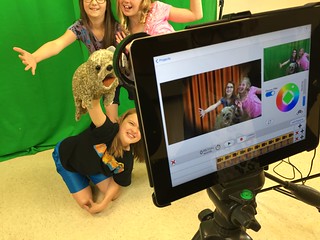 2 Classrooms: I am blessed to have two classrooms to teach in, which are side-by-side. This year I’ve made our second classroom into a Maker Studio, which is a bit like a MakerSpace but not one that is “fully” outfitted.
2 Classrooms: I am blessed to have two classrooms to teach in, which are side-by-side. This year I’ve made our second classroom into a Maker Studio, which is a bit like a MakerSpace but not one that is “fully” outfitted.- Curricular Autonomy: One of the things I value most of all, being a STEM teacher, is curricular autonomy. We do not have pacing guides or textbooks. I rely extensively on the lesson ideas and generous curricular sharing of others, including my peer STEM teacher at Lakeview Elementary School, Amy Loeffelholz (@AmyLoeffelholz). Our desire to encourage more STEM lesson idea sharing was the genesis of STEMseeds and our 3 day STEMseeds PD camp, which Amy and I will be teaching together June 2-4, 2015. Autonomy of any kind can be a rare commodity in K-12 public schools in the United States in 2015, given our national focus on high stakes testing and accountability. STEM class is a breath of needed, fresh air in MANY ways, and curricular autonomy is one of them. All my lessons from the past 2 years in STEM class are detailed with links and handouts on stem.wesfryer.com.
- Twice Per Week Schedule: The first two years of the STEM program at our school, students just came to STEM once per week. This meant the STEM teacher taught the same two lessons eleven times each (if lessons were different for 4th and 5th grade) or the same lesson 22 times. The previous STEM teacher, Chris Simon (@chriswsimon) likened this to the movie “Groundhog Day.” When I started teaching STEM at IES 2 years ago, thankfully the schedule changed so students came twice per week, but only for one semester. The semester students didn’t have STEM, they went to Art. A similar rotation was kept in our new schedule this year, so students come to STEM for 2 days in a row. This means some weeks a class will come three times, other weeks they will come twice. I really like this. It would be much more challenging to impact my students in ways I hope I do if I only saw them once per week.
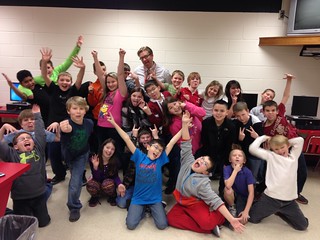 Makers Club Sandbox: Last year and this year I’ve sponsored an after-school Makers Club for students, which gives them opportunities to build and make things in addition to those provided in STEM classes. Many of the students each semester choose to build and work in MinecraftEDU, but students also choose to do many other creative things. Not only is it personally energizing to work with these enthusiastic students once per week after school, it’s also beneficial for my STEM lessons. On several occasions, I’ve piloted a lesson idea (like water bottle rockets) with my Makers Club students first, to work out the kinks and see how things go. I love Makers Club!
Makers Club Sandbox: Last year and this year I’ve sponsored an after-school Makers Club for students, which gives them opportunities to build and make things in addition to those provided in STEM classes. Many of the students each semester choose to build and work in MinecraftEDU, but students also choose to do many other creative things. Not only is it personally energizing to work with these enthusiastic students once per week after school, it’s also beneficial for my STEM lessons. On several occasions, I’ve piloted a lesson idea (like water bottle rockets) with my Makers Club students first, to work out the kinks and see how things go. I love Makers Club!- Curiosity Links: In March of 2014 I started sharing weekly “curiosity links” with my students during class. I don’t share these every day, but I try to share some at least weekly. These are usually short videos, and often come from Twitter lists I’ve made and regularly explore via FlipBoard for other STEM teachers and STEM Innovation. I think it is vitally important, as a STEM teacher, that I try to inspire my students to be curious, to ask questions, to wonder, to use their imagination, and understand that we’re only just STARTING to understand our universe through the lenses of science, technology, engineering and math. I love that many of my students now love “curiosity link time.” Curiosity links have allowed me to have many great conversations and discussions with my students, both during the start of our lessons as well as at other times. I LOVE LOVE LOVE sharing curiosity links with my students!
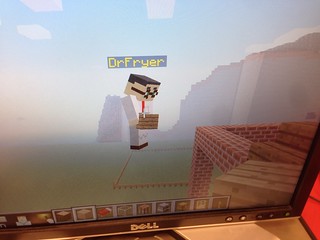 MinecraftEDU: The first year I started teaching STEM at IES I used the remaining money (about $425) in our STEM budget on 29 licenses for MincraftEDU software. This was money VERY well spent. The level of immersive engagement and complex problem solving I’ve seen students engage in via Minecraft and MinecraftEDU is staggering. I’ve blogged before (or maybe tweeted) that ignoring the positive potential of Minecraft to serve learning objectives both inside and outside the classroom is tantamount today to professional negligence. As teachers in 2015 we simply can’t ignore Minecraft: To do so would be like ignoring the fact that students need to eat. So many of our kids are already playing, building, and learning in Minecraft at home. Minecraft can be used and thought of in many ways, but one is an open building world with unlimited Lego bricks. I love being able to create lessons for entire classes using MinecraftEDU and facilitate them in our computer lab down the hall, and being able to use different challenge scenarios for MinecraftEDU in our Maker Studio.
MinecraftEDU: The first year I started teaching STEM at IES I used the remaining money (about $425) in our STEM budget on 29 licenses for MincraftEDU software. This was money VERY well spent. The level of immersive engagement and complex problem solving I’ve seen students engage in via Minecraft and MinecraftEDU is staggering. I’ve blogged before (or maybe tweeted) that ignoring the positive potential of Minecraft to serve learning objectives both inside and outside the classroom is tantamount today to professional negligence. As teachers in 2015 we simply can’t ignore Minecraft: To do so would be like ignoring the fact that students need to eat. So many of our kids are already playing, building, and learning in Minecraft at home. Minecraft can be used and thought of in many ways, but one is an open building world with unlimited Lego bricks. I love being able to create lessons for entire classes using MinecraftEDU and facilitate them in our computer lab down the hall, and being able to use different challenge scenarios for MinecraftEDU in our Maker Studio.- Minecraft Conversations: I love how the fact that I play Minecraft and we use MinecraftEDU in STEM class has encouraged many of our students to talk with me frequently about Minecraft “stuff.” So many kids want and need an adult to listen to them, to be interested in what they have to say, and to take them seriously. Of about 50 staff at our school, only 2 of us are male. It’s a big deal to have these kinds of conversations with students. It builds connections and relationships. Small talk matters. Minecraft has opened MANY of these doors to dialog with students for me the past two years.
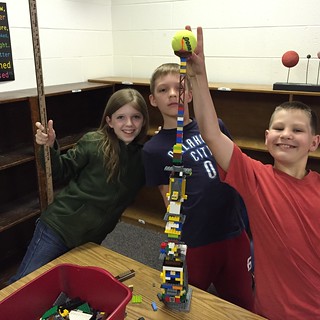 Multi-Disciplinary Approaches to Learning: I love how good STEM lessons are naturally multi-disciplinary. Take our current series of Engineering Design Challenges as an example. Students plan and design a prototype. They build and test it. They conduct measurements. They use technology to capture their work, and later narrate video slideshows reflecting on their process, product, and learning. Good STEM lessons constantly involve the practical application of scientific concepts to solve problems (that’s engineering) as well as opportunities to practice fluent communication and literacy skills. These kinds of integrated lessons should be in ALL classrooms, btw, not just official “STEM classrooms” like mine. Knowledge and skills are contextual and therefore meaningful to kids. The learning isn’t “just in case,” it’s “just in time.” Students love STEM because it’s real, it’s challenging, it’s hands on, and it’s active. They don’t realize they are simultaneously working on mastering multi-disciplinarily curricular objectives. It’s just how we roll.
Multi-Disciplinary Approaches to Learning: I love how good STEM lessons are naturally multi-disciplinary. Take our current series of Engineering Design Challenges as an example. Students plan and design a prototype. They build and test it. They conduct measurements. They use technology to capture their work, and later narrate video slideshows reflecting on their process, product, and learning. Good STEM lessons constantly involve the practical application of scientific concepts to solve problems (that’s engineering) as well as opportunities to practice fluent communication and literacy skills. These kinds of integrated lessons should be in ALL classrooms, btw, not just official “STEM classrooms” like mine. Knowledge and skills are contextual and therefore meaningful to kids. The learning isn’t “just in case,” it’s “just in time.” Students love STEM because it’s real, it’s challenging, it’s hands on, and it’s active. They don’t realize they are simultaneously working on mastering multi-disciplinarily curricular objectives. It’s just how we roll.- Introducing Coding: Oh how I love introducing students to coding! Whether it’s Scratch, Hopscotch, Code.org or now Scratch Jr., I love the complexity and engagement which always comes with coding lessons. See my curriculum page for iPad Coding for more on this.
- Collaborating with our Librarian: I love to collaborate with other teachers. This year, our end-of-school “TRIP” time (To Read Is Power – it’s a 20 minute sustained silent reading time we called DEAR time at a previous school) has provided the main collaboration time for me. Our Enhanced eBook Project has been a big success this year, and has allowed over 50 students to learn how to create and share multimedia ebooks that include text, images, and recorded audio narration.
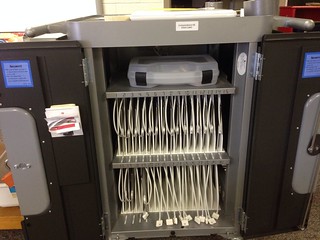 iPad Cart Media Production: Our classroom is blessed to be one of the few classes in our entire school district with our own, dedicated cart of 20 iPads. It is wonderfully beneficial to have this dedicated cart which we do not have to share with other classes. One of the primary ways we use our iPads is to document and amplify our learning. The playlists saved to my STEM classroom YouTube channel include narrated slideshows about our MinecraftEDU perimeter and area challenge this spring, enhanced eBooks about the same project created by my students in the fall, Rube Goldberg projects from our Maker Studio, Green Screen videos, Lego Stopmotion videos, and more. A list of the 70+ apps we use on our STEM iPads is available on the About page of my STEM curriculum website.
iPad Cart Media Production: Our classroom is blessed to be one of the few classes in our entire school district with our own, dedicated cart of 20 iPads. It is wonderfully beneficial to have this dedicated cart which we do not have to share with other classes. One of the primary ways we use our iPads is to document and amplify our learning. The playlists saved to my STEM classroom YouTube channel include narrated slideshows about our MinecraftEDU perimeter and area challenge this spring, enhanced eBooks about the same project created by my students in the fall, Rube Goldberg projects from our Maker Studio, Green Screen videos, Lego Stopmotion videos, and more. A list of the 70+ apps we use on our STEM iPads is available on the About page of my STEM curriculum website.- Everyone Participates: It’s wonderful and critical that ALL students participate in STEM at our school. This isn’t a class just for GE (Gifted Education) students or an elective for a few students. Of course it can be very challenging to have ALL th students in our classes, including those with IEPs (individual education plans) requiring significant lesson accommodations. The process of legally signing all the IEPs for a school of 610 students at the start of the year is an intimidating process, to say the least. I try and design most STEM lessons to be collaborative activities, however, which permit students to have different roles depending on their interests and abilities.
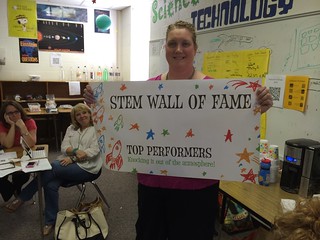 Collaborating with Amy: The best thing about teaching STEM in Yukon Public Schools has been the opportunity to collaborate with the other grade 4-5 STEM teacher at Lakeview Elementary, Amy Loeffelholz. (@AmyLoeffelholz) Without Amy’s generous and fantastic assistance, I would be and have been a far less effective STEM teacher the past two years. The 2 day STEM camp we facilitated together in June 2014 (and are offering again as a 3 day STEM PD Camp June 2-4, 2015) was a huge instructional benefit to me personally. Many of the STEM lessons and units you’ll find on stem.wesfryer.com are directly from Amy’s own lesson plan archive. Although we’ve had relatively few opportunities to get together face-to-face (F2F) this year, collaboration with Amy remains one of my most valued and appreciated teaching experiences the past two years.
Collaborating with Amy: The best thing about teaching STEM in Yukon Public Schools has been the opportunity to collaborate with the other grade 4-5 STEM teacher at Lakeview Elementary, Amy Loeffelholz. (@AmyLoeffelholz) Without Amy’s generous and fantastic assistance, I would be and have been a far less effective STEM teacher the past two years. The 2 day STEM camp we facilitated together in June 2014 (and are offering again as a 3 day STEM PD Camp June 2-4, 2015) was a huge instructional benefit to me personally. Many of the STEM lessons and units you’ll find on stem.wesfryer.com are directly from Amy’s own lesson plan archive. Although we’ve had relatively few opportunities to get together face-to-face (F2F) this year, collaboration with Amy remains one of my most valued and appreciated teaching experiences the past two years.- STEMseeds: Since Amy and I have relatively few opportunities to meet F2F, last year after I started teaching STEM we decided to start an irregular web show / podcast and website. We named it STEMseeds, based on the fantastic “Seedlings Podcast” by Bob Sprankle, Cheryl Oakes and Alice Barr. We’ve published 10 shows on STEMseeds.org since we started in March 2013. Several of my STEM lessons, including the series of 4 Engineering Design Challenges my students have worked on since Spring Break, came directly from these STEMseeds Google Hangouts. I’m not sure we’ll establish a show schedule that is much more regular in the year ahead, but I do hope and anticipate we’ll continue building the STEMseeds community and resource collection. Follow @STEMseeds on Twitter for updates.
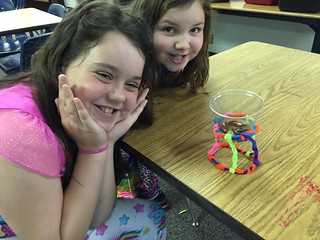 Engineering Design Projects: Some of my favorite STEM lessons, and I think favorites of my students the past two years, have been Engineering Design Projects. Several of theses came directly from Nevada STEM coordinator and STEM teacher extraordinaire, Brian Crosby. Last year these included the Marshmallow Challenge and the Cantilever Spans design challenge. This semester our Engineering Design Challenges have included Paper Tables, Straw Structures, Pipe Cleaner Structures, and Tennis Ball Lego Towers.
Engineering Design Projects: Some of my favorite STEM lessons, and I think favorites of my students the past two years, have been Engineering Design Projects. Several of theses came directly from Nevada STEM coordinator and STEM teacher extraordinaire, Brian Crosby. Last year these included the Marshmallow Challenge and the Cantilever Spans design challenge. This semester our Engineering Design Challenges have included Paper Tables, Straw Structures, Pipe Cleaner Structures, and Tennis Ball Lego Towers.- Maker Studio – Elective Choice: My favorite instructional change this past year has been the addition of our Maker Studio. This is a five station, center-based classroom adjacent to my main STEM classroom. The Maker Studio stations we’ve used this year include Green Screen, Sphero, Rube Goldberg, MincraftEDU, Lego Stopmotion, Digital Music Creation, and Makey Makey. Each lesson rotation cycle, half the students in each STEM class draw a number from a tub and select the Maker Studio station they want to “create in” for the next four lessons. I don’t let students repeat a Maker Studio selection (they have to choose a new station each time) and each semester, students have been able to select three different centers. I wanted students to spend four different lessons in the same Maker Studio station, and experience fewer stations rather than more, because I want them to develop a higher level of comfort and fluency/skill set with their chosen station than they would if they just spent 1 or 2 lessons within that activity. I described the Maker Studio experience to my students at the start of each semester as “like recess, except you MAKE things.” My students have loved Maker Studio, and it’s been the primary way I’ve tried to help my students see themselves as makers, tinkerers, problem solvers, and inventors. The playlist of short Rube Goldberg project videos may not seem groundbreaking, but they represent some EXCELLENT examples of student problem solving and creativity! I love the fact that we’ve been able to have a Maker Studio this year and that my students love it. STEM class has been largely defined in the minds of my students this year by Maker Studio, and I think that is as it should be. The fact that students get to CHOOSE their maker studio stations is also critical. Generally, our 4th and 5th students have relatively few opportunities to make authentic curricular or academic choices at school. It’s a big deal to empower them to select Maker Studio stations, and this also increases their interest and engagement levels in STEM class.
- Collaboration Practice for Students: It can be very challenging and taxing to facilitate group projects with students. Some students are natural collaborators, but in my experience most are not. Even though this is challenging, it’s EXTREMELY important that we help students develop their capacities to collaborate and work with others. There are many things we hear from employers in surveys about “desired work skills.” The ability to cooperate and work with others is consistently one of the things employers say they want. Integrating collaboration into classroom lessons isn’t just about workforce skills, however, it’s also about life skills. The lack of collaboration skills which many of our students exhibit is in part developmental, but it’s also a function of the emphasis educational policymakers have encouraged teachers to have in the classroom on individual performance / achievement as measured by standardized tests. I love that our STEM program and STEM lessons emphasize group collaboration every day.
- Robust Connectivity: We are blessed in Yukon Public Schools to have robust wifi connectivity and Internet bandwidth. I’ve led workshops and taught classes in other places, in the past, where that was not the case. With our classroom cart of 20 iPads, it’s fantastic to have reliable, fast connectivity when students utilize the Internet to access information or publish it as text or videos.
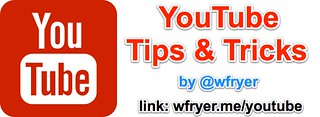 YouTube Video Publishing: I love the fact that our school district adopted GAFE (Google Apps for Education) about five years ago. While we have not yet provided students with Google accounts, all our teachers have them and continue to become more familiar using Google Docs as well as Gmail. I’ve helped several of our teachers the past two years create their own classroom YouTube accounts, as well as some shared YouTube accounts: iesYukon for our schoolwide /faculty interview videos and IES Student projects as a shared space this year to publish both GE (Gifted Education) and Library eBook Project videos. We currently have 433 videos on our STEM classroom YouTube channel, and the vast majority of those are student-created videos.
YouTube Video Publishing: I love the fact that our school district adopted GAFE (Google Apps for Education) about five years ago. While we have not yet provided students with Google accounts, all our teachers have them and continue to become more familiar using Google Docs as well as Gmail. I’ve helped several of our teachers the past two years create their own classroom YouTube accounts, as well as some shared YouTube accounts: iesYukon for our schoolwide /faculty interview videos and IES Student projects as a shared space this year to publish both GE (Gifted Education) and Library eBook Project videos. We currently have 433 videos on our STEM classroom YouTube channel, and the vast majority of those are student-created videos.- Teacher Filter Bypass: Along with robust Internet connectivity, we are blessed in our school district to have IT policies which both trust and support teachers as instructional leaders. Our Lightspeed Internet content filter permits teachers to login and bypass the content filter to access content not available for students. This currently includes websites like Facebook and Twitter, and full access to YouTube. This includes the ability to upload YouTube videos directly. I’ve configured our classroom YouTube channel to permit students to email short videos for direct uploading/publishing, but longer videos still require me to login and bypass the filter. I cannot over-emphasize the importance of our school district trusting teachers to bypass the filter and upload videos to YouTube to me as a STEM teacher. Videos are a vital part of our learning process in STEM class, and it’s very difficult for me to imagine teaching STEM now without the ability to both flexibility access as well as publish videos on and to YouTube. Photos are also an essential part of our learning, documenting and sharing what we’re making each day. Over the past years, I’ve published 45 different photo albums to Flickr from our STEM lessons. As with YouTube, I’m immensely thankful to our district administration for permitting open teacher and student access to Flickr as well as YouTube for media publication.
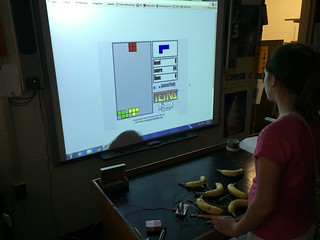 Reliable Data Projector: I use the data projector every day in my classroom, in every class. I frequently share videos as “Curiosity Links.” As with YouTube and Flickr, I can’t imagine teaching my STEM class without a reliable data projector. Our district purchased an LED-based data projector for my classroom before I starting teaching there, and this projector has proved to be extremely reliable and bright.
Reliable Data Projector: I use the data projector every day in my classroom, in every class. I frequently share videos as “Curiosity Links.” As with YouTube and Flickr, I can’t imagine teaching my STEM class without a reliable data projector. Our district purchased an LED-based data projector for my classroom before I starting teaching there, and this projector has proved to be extremely reliable and bright.- AppleTV iPad Screen Sharing: Particularly when I teach students iPad coding using Hopscotch, students love to share their iPad screens with classmates by “mirroring” them to our classroom projector. Before my principal purchased an AppleTV for our STEM classroom earlier this semester, I used AirServer software to make my laptop into an AirPlay-capable projection device. This essentially makes my laptop function like an AppleTV. This is an extremely useful capability for my classroom, where we use an iPad cart of 20 iPads. I frequently demonstrate how to do different things in iPad apps for my students using AirPlay mirroring.
- Teacher Collaboration: In addition to my collaborations with fellow STEM teacher Amy Loeffelholz the past two years, I have valued and enjoyed my collaborations with our art teacher and GE (Gifted Education) teacher, whose classrooms are both adjacent to mine. I’ve also thoroughly enjoyed collaborating with both the librarians we’ve had the past two years. I love instructional coaching, and although my schedule this year has been very limited in terms of the collaboration opportunities it provides, there have been some times to work together. I’ve helped our art teacher with stopmotion projects and helped our GE teacher facilitate student “quick edit” videos using visual notes and green screen videos. I’ve helped our librarian facilitate a digital audio book report project (focusing on the Sequoyah Book Series) as well as an enhanced eBook book report project.
 Donors Choose (Spheros): I’ve loved the opportunity to utilize DonorsChoose.org this year to obtain additional technology equipment for our STEM classroom, and specifically for our Maker Studio. I bought one Sphero robotic ball last summer to use in class, but the battery in a Sphero won’t last all day. By getting 3 additional Spheros donated to our classroom, students in our Maker Studio have been able to use two Spheros per class and thereby preserve enough battery power to enable students in each of my classes to use them.
Donors Choose (Spheros): I’ve loved the opportunity to utilize DonorsChoose.org this year to obtain additional technology equipment for our STEM classroom, and specifically for our Maker Studio. I bought one Sphero robotic ball last summer to use in class, but the battery in a Sphero won’t last all day. By getting 3 additional Spheros donated to our classroom, students in our Maker Studio have been able to use two Spheros per class and thereby preserve enough battery power to enable students in each of my classes to use them.- Introducing Interactive Writing: I’m a huge advocate for digital interactive writing for students. Both last year and this year, I created free KidBlog websites for each of the classes at our school. Last year we had 22 classes, this year we have 24 classes. Teaching students how to publish text, post appropriate comments, post images, and embed YouTube videos has been an important part of our STEM curriculum and something I’m thankful to be able to teach my students in STEM class.
- After School Outside Duty: Every other week as the STEM teacher at our school, I have outside duty to direct parents driving their cars to pick up their children after school. Although there have been occasional irate parents to deal with, overall I’ve loved the opportunity to spend about 30 minutes outside on these days. I wish I had more opportunities to be outside and to take students outside at school. I’m thankful my after-school duties have included this “outside time.”
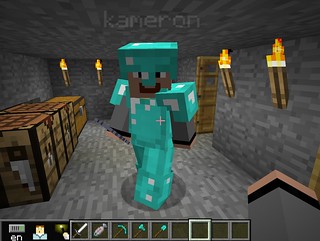 Breakfast Conversations with Kids: About every other month, our “specials” team has morning duty at school. This means together, our art, music, PE, and GE teachers and I help supervise students in the cafeteria having breakfast, in the gym waiting for morning assembly, and supervise the crosswalk where parents drop off students in front of our building. I have enjoyed all these roles this year, but especially the conversations I’ve had with students at breakfast in the cafeteria. Because we use MinecraftEDU in STEM class and students know I play / have knowledge of Minecraft, this has “opened up a door” for me to have many, many conversations with our students. We have about 45 educators, both certified and non-certified, on staff at our school. We have several male custodians, but just two male teachers, including me. It’s so important for kids at school to make positive, relational connections to adults. I really treasure these opportunities in the morning to have small but important conversations with students. I don’t value them so much that I’ve signed up for extra morning duties, but I certainly have taken away an acute sense each time I’ve had morning duty that the conversations we have with kids matter. So many students just want to be listened to, and talking about Minecraft has opened up more doors for conversations with students in the past two years than I can count.
Breakfast Conversations with Kids: About every other month, our “specials” team has morning duty at school. This means together, our art, music, PE, and GE teachers and I help supervise students in the cafeteria having breakfast, in the gym waiting for morning assembly, and supervise the crosswalk where parents drop off students in front of our building. I have enjoyed all these roles this year, but especially the conversations I’ve had with students at breakfast in the cafeteria. Because we use MinecraftEDU in STEM class and students know I play / have knowledge of Minecraft, this has “opened up a door” for me to have many, many conversations with our students. We have about 45 educators, both certified and non-certified, on staff at our school. We have several male custodians, but just two male teachers, including me. It’s so important for kids at school to make positive, relational connections to adults. I really treasure these opportunities in the morning to have small but important conversations with students. I don’t value them so much that I’ve signed up for extra morning duties, but I certainly have taken away an acute sense each time I’ve had morning duty that the conversations we have with kids matter. So many students just want to be listened to, and talking about Minecraft has opened up more doors for conversations with students in the past two years than I can count.- Relationships with Custodians and Office Staff: People who don’t know me well think I’m a “technology guy.” I do know a lot about technology, but I’m really “a relationship guy.” It can take a long time to build relationships with other adults with whom we work. It takes awhile for people to get to know you, and even longer for them to trust you. I really value all the relationships I’ve developed at our school, and these include those with our office staff and our custodial staff. These folks are really the anchors of our school, and I greatly value the important role they play in our lives and the lives of our students each day.
- Participation Grades: I’m so thankful that as a STEM teacher at our school, I just have to give participation grades. These grades take the form of A-F grades, but in almost all cases my students earn A’s for their participation in STEM class. Having about 305 students per semester, it would be a nightmare if I had to give actual academic performance grades each semester. In two years of teaching STEM, I think I’ve only heard one student ask me the question, “Is this for a grade?” In our class, we don’t even talk about grades. Students don’t ask about it, and I don’t mention it. STEM is about building, making, working together, and solving problems. It’s not about earning grades or making grades. This is another way our STEM classroom includes learning that is hopefully very real-world. We certainly assess our learning, and I definitely challenge students to master new skills and learn new knowledge. We regularly document our learning via photos, videos, and blog posts. Thankfully, however, I don’t have to give grades for these activities beyond noting student participation.
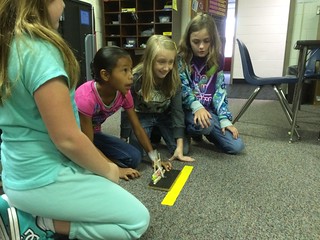 Show and Share Excitement: Curiosity Links, which I share at least once per week with my students, have definitely been one of my favorite parts of our STEM classes the past two years. Sharing those videos, articles, apps, and links are one way I try and convey my own excitement for STEM and work in STEM fields to my students. Our STEM units, which this year have included building catapults, prosthetic hands, Hopscotch coding programs, collaborative MinecraftEDU builds, and Engineering Design Challenges, are another way I try to share my enthusiasm for STEM. When teachers are passionate about learning and specific topics, often that interest and passion “rubs off” on students. I hope my students remember how much I love STEM and learning about STEM, and they pursue more STEM studies as a result!
Show and Share Excitement: Curiosity Links, which I share at least once per week with my students, have definitely been one of my favorite parts of our STEM classes the past two years. Sharing those videos, articles, apps, and links are one way I try and convey my own excitement for STEM and work in STEM fields to my students. Our STEM units, which this year have included building catapults, prosthetic hands, Hopscotch coding programs, collaborative MinecraftEDU builds, and Engineering Design Challenges, are another way I try to share my enthusiasm for STEM. When teachers are passionate about learning and specific topics, often that interest and passion “rubs off” on students. I hope my students remember how much I love STEM and learning about STEM, and they pursue more STEM studies as a result!
I could probably keep this list going, but I’ll stop there at 30 reasons. STEM is a great subject to teach, particularly if you’re fortunate to work in a supportive school environment. To learn more about STEM lessons my students have experienced and enjoyed, visit my STEM classroom and curriculum site: stem.wesfryer.com. This post has taken me a couple weeks to finish, as I wanted to elaborate a bit on each reason which I initially brainstormed.
For more background about our STEM program in YPS, check out the STEM page of our school website. If you’re more interested in elementary STEM lessons, please join Amy and I for our 3 day “STEM Seeds PD Camp” June 2-4, 2015 in Yukon.
If you enjoyed this post and found it useful, subscribe to Wes’ free newsletter. Check out Wes’ video tutorial library, “Playing with Media.” Information about more ways to learn with Dr. Wesley Fryer are available on wesfryer.com/after.
On this day..
- Oklahoma Governor Mary Fallin Misunderstands Testing and School Quality – 2017
- Quick Edit Video: Water Bottle Rocket Launch – 2014
- 3rd Graders Research Animals with 4 iPads, AudioBoo and PebbleGo – 2013
- iPad Media Camp in Oklahoma City: July 11, 12 & 13, 2012 – 2012
- Common Core Guitar Songs, Lady Gaga Remixes & Commercial Underwriters – 2012
- Google Docs on the iPad with Office2 Pro – 2010
- Conan on the iPad – 2010
- Powerful Ingredients for Digitally Interactive Learning in Amarillo May 16th – 2009
- Adware blocked by OpenDNS – 2008
- Innovative teachers wanted under the Big Tree in SF! – 2008



